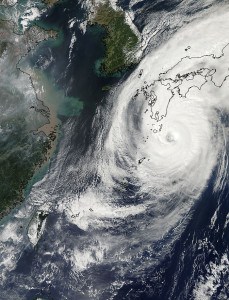Rail services resumed and evacuation advisories were lifted in Tokyo after Typhoon Phanfone passed over the Japanese capital on its way back out to sea. The storm caused at least one death at a U.S. air base in Okinawa.
Heavy rain warnings remained in effect for coastal areas from the central prefecture of Aichi to Iwate in northern Japan. Phanfone was centered about 100 kilometers (62 miles) east of Hitachi, a coastal city north of Tokyo, as of 1:45 p.m. according to the Japan Meteorological Agency. The storm had sustained winds of 126 kilometers (78 miles) per hour, equal to a
Category 1 hurricane, the weakest on the five-step Saffir- Simpson scale.

NASA’s Goddard Space Flight Center
Phanfone yesterday washed three airmen out to sea at Kadena Air Base in Okinawa, Japan’s southernmost prefecture, according to a statement on the base’s website. One of the airmen was found by Japan’s coast guard and pronounced dead, while the two others remain missing.
At its peak intensity in Tokyo today between 9 a.m. and 10 a.m., the storm dumped 27 centimeters of rain on the capital.
Flights Canceled
Clear skies and temperatures of 26 degrees Celsius (79 Fahrenheit) came to Tokyo after the storm’s passage. City officials lifted an advisory at about 1:30 p.m. urging residents of 22,900 households in central Minato ward to flee their homes for public shelters due to heightened landslide risk, according to a statement on the ward’s website.
Central Japan Railway Co. was operating the Tokaido Shinkansen high-speed train between Tokyo and Osaka with some delays after the storm prompted the cancellation of service earlier in the day, the company said on its website.
Japan Airlines Co. canceled 195 domestic flights, impacting more than 25,000 passengers as of 2 p.m., the company said in a faxed statement. ANA Holdings Co.’s All Nippon Airways canceled 261 domestic flights, affecting 36,600 people, according to a faxed statement.
Skymark Airlines Inc., Japan’s third-largest carrier, canceled 57 flights, impacting 5,900 people, spokesman Hiroyuki Sakata said by phone.
Factory Delays
Toyota Motor Corp. planned to resume production during night shifts at 12 Aichi prefecture plants where day shifts had been halted due to the typhoon, spokesman Danny Chen said by phone. Honda Motor Co. delayed the start of operations at two plants in central Japan, spokesman Teruhiko Tatebe said.
Nissan Motor Co. instructed workers at its Yokohama headquarters not to report to work today because of the storm, spokesman Toshitake Inoshita said in an e-mail. The start of work at Nissan’s Oppama plant was delayed until afternoon, Inoshita said.
Japan has averaged more than 11 typhoons per year, most occurring between July and October, over the 30-year period ended in 2010, according to the weather agency. Neoguri in July left at least three dead after passing over Kyushu and skirting the nation’s Pacific coast; Halong in August disrupted travel in the nation’s southwestern region. Phanfone is Japan’s 18th typhoon so far this season.
The search for victims of the volcanic eruption of Mt. Ontake in central Japan has been stopped by heavy rain brought by the storm, Kyodo News reported yesterday. At least 12 people remain missing after the eruption, which has so far claimed 51 lives, Kyodo said.
(With assistance from Ma Jie and Craig Trudell in Tokyo.)
Was this article valuable?
Here are more articles you may enjoy.

 Oregon Schools Sued for $9M After Young Girl Allegedly Raped
Oregon Schools Sued for $9M After Young Girl Allegedly Raped  Hawaiian Electric Hits 40-Year Low Ahead of Maui Fire Report
Hawaiian Electric Hits 40-Year Low Ahead of Maui Fire Report  Justice Department Preparing Ticketmaster Antitrust Lawsuit
Justice Department Preparing Ticketmaster Antitrust Lawsuit  Viewpoint: The Impact of Behavioral Health on Workers’ Comp
Viewpoint: The Impact of Behavioral Health on Workers’ Comp 